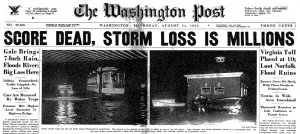We would like to introduce a new segment to the NHF Blog page: Washington Navy Yard: Then and Now. We will be showing the growth and changes in Washington Navy Yard history from yesterday through today. Today’s images discuss Building 201, just a few blocks from the National Museum of the United States Navy.
 The included images show the south and east elevations of the building residing on the corner of Sicard Street and Patterson Ave. The first image on the left date’s back to 1933. At the time, it was known as Building 142, or the Radio Material Shop. The bottom description of the painting reads:
The included images show the south and east elevations of the building residing on the corner of Sicard Street and Patterson Ave. The first image on the left date’s back to 1933. At the time, it was known as Building 142, or the Radio Material Shop. The bottom description of the painting reads:
Navy Yard, Washington, D.C. View of Bldgs. 142 and 162-Radio Material Shop. High water mark is being pinnated out at near corner of building. Taken 24 August, 1933, the morning after the flood.
The 1933 Chesapeake-Potomac hurricane still ranks among the most damaging hurricanes along the mid-Atlantic states. According to a report done by the Weather Prediction Center, the storm was the sixth in a long series of damaging storms during 1933. Although the storm made landfall in North Carolina on 23 August, slowly weakening to a tropical storm over parts of Washington, D.C. later in the day. The storm continued to move north, causing damage as far as Pennsylvania, New York, and Canada until it dissipated on 28 August. Both the Potomac and Anacostia Rivers flooded, causing a large surge of water to the edges of the Washington Navy Yard. The high water mark indicated in the photograph on the left shows the immensity of the storm surge. During World War II, the building is listed in a survey of the Naval Gun Factory as “Shop, radio test Addition.”
The middle photo was taken in 1997. According to a 1997 study done by the EPA, the building was then referred to as the “Public Works Maintenance Shop.” Many of the trappings of the modern day are present, including the noticeable paved roads. The white arch over the south side of the building is a clear indication of its similarity to the 1933 photo.
Further advancements were made in the Washington Navy Yard over the last fifteen to twenty years. The photo on the right was taken two days ago. It shows the furthest reach of the road (Sicard Street and Patterson Ave.) now encompasses Building No. 201, directly across from the Chapel. For years, building 201 sat behind No. 142 on Patterson. It is now the entire edge of the block. At some point between 1997 and the present day, building No. 142 was demolished to expand Building No. 201. No. 201 now houses the NAVSEA offices that manage aircraft carriers, submarines, and littoral combat ships. It was also a major location to evacuate during the September WNY shootings.
Photo Credits: Library of Congress
(Left Photo: #HABS DC,WASH,074M–6)
(Middle Photo: #HABS DC,WASH,074M–1)
(Right Photo: Matthew Eng, 2013)
——————
The history of the Washington Navy Yard was captured in a 1999-government published monograph “THE WASHINGTON NAVY YARD.” With demand for this out of print publication continuing, the Naval Historical Foundation commissioned another print-run of the book with updates to make the book current, including material about the recent 16 September Navy Yard Shootings and commemorations about the bicentennial of the yard’s burning in 1814. This updated special Memorial-Commemoration edition is now on sale at the Navy Museum Store.


